Ferromagnetism in CeCo3B2
Intermetallic compounds under a common formular expression Cen+1Co3n+5B2n
with n = 1, 2, 3 and ∞ have attracted attention during the last decade due largely to
their rich variety of magnetic phenomena [1-4]. The crystallographic structures of these
compounds are hexagonal and closely related to each other and to CeCo5 (CaCu5 type of
structure) by ordered substitution of Co at the 2c sites by B atoms [5]. Upon increasing
n, the lattice parameters a are found almost constant, while the normalized (per formular
unit) c parameters decrease, resulting in a systematic decrease of Ce-Ce interatomic distance along the c axis from ∼ 4 ˚ A in CeCo5 to ∼ 3 ˚ A in CeCo3B2(n = ∞), while in the
basal plane Ce-Ce distance is of little change, of about 5 ˚ A. For CeCo3B2, all 2c sites are
occupied by B atoms, and Co atoms are found only at 3g sites. Thus the structure of this
compound is built by alternatively stacking of the two layers, a closely packed Co atom
layer and the one containing Ce and B atoms and the difference in Ce-Ce distances along
the c-axis and in the basal plane makes Ce atoms to form a pseudo-1D chain along the
c-axis.
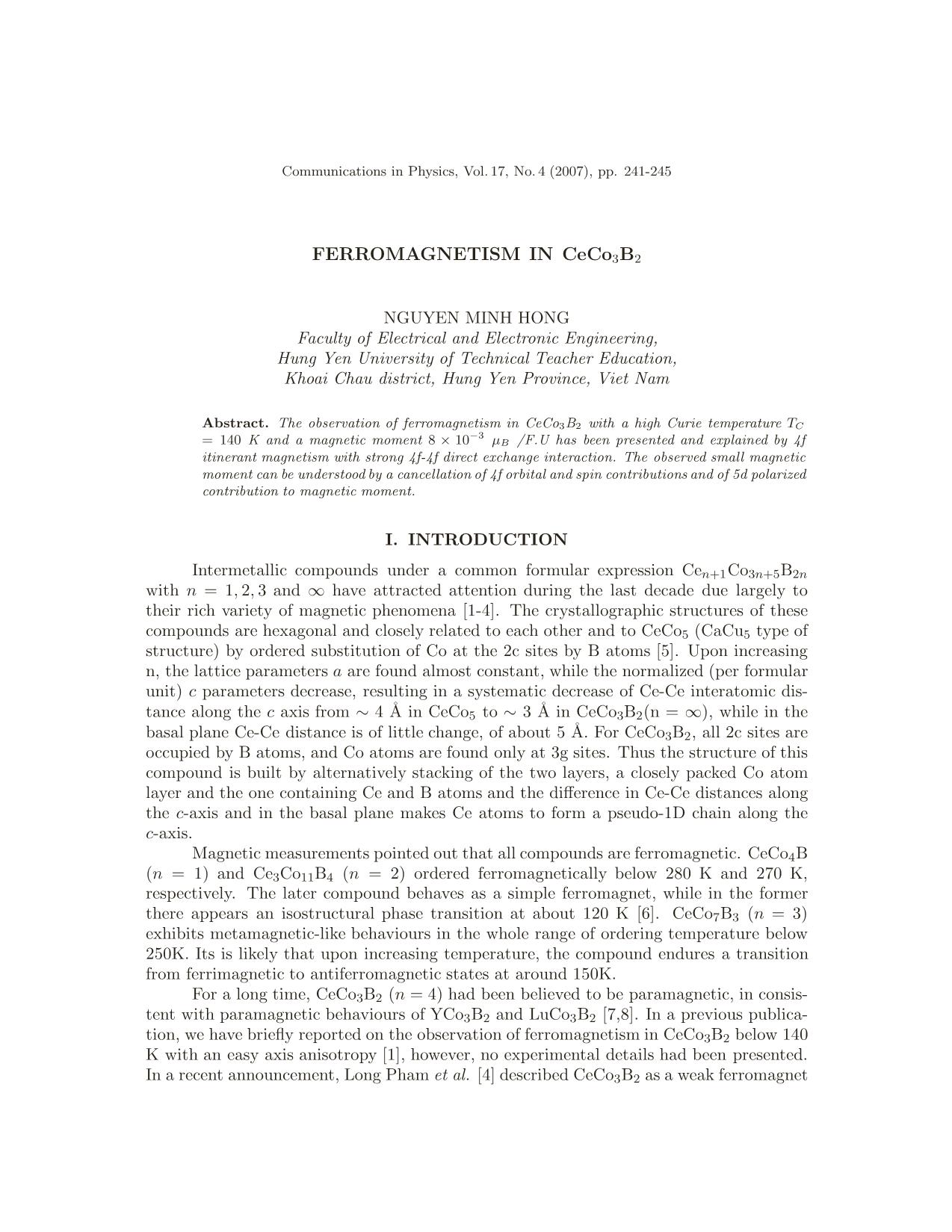
Trang 1
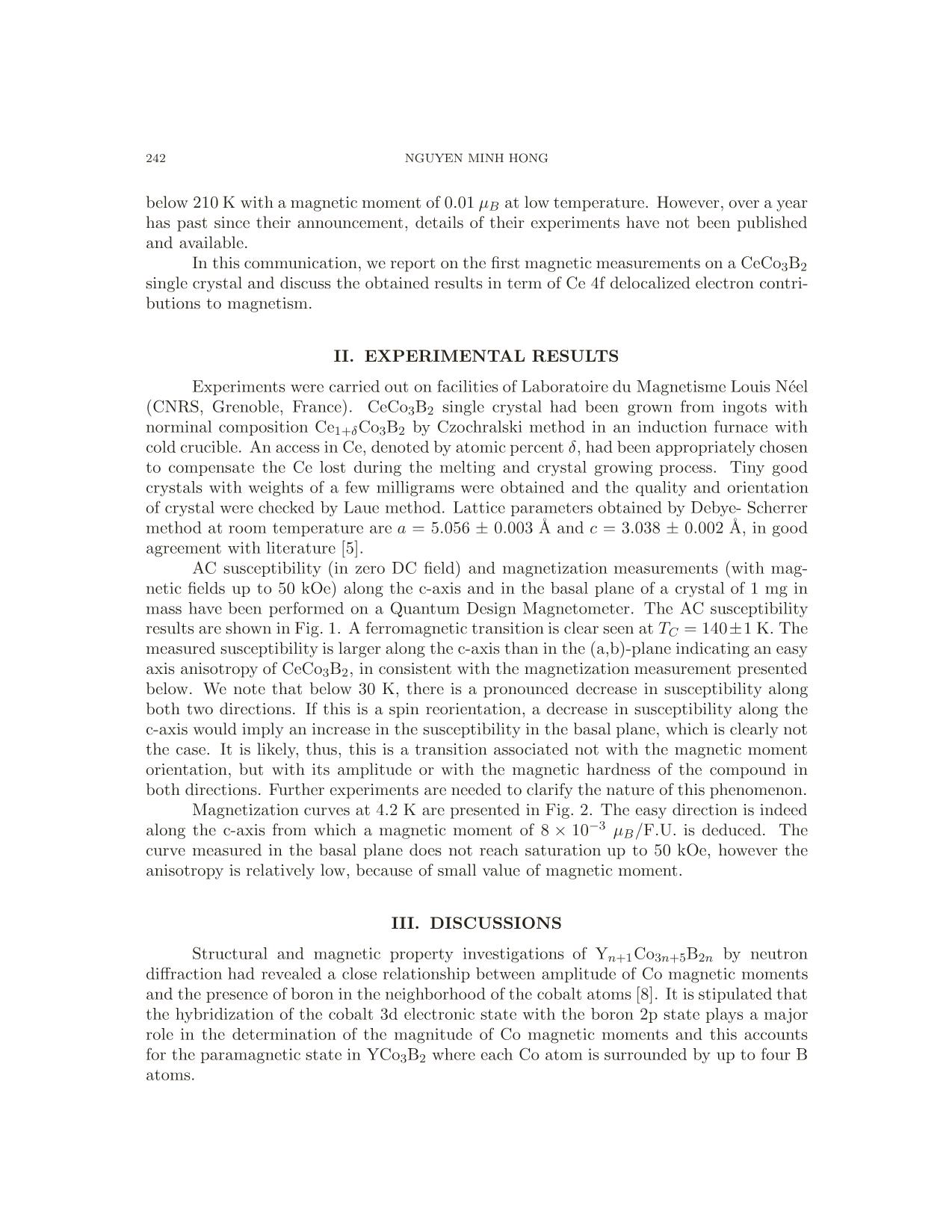
Trang 2
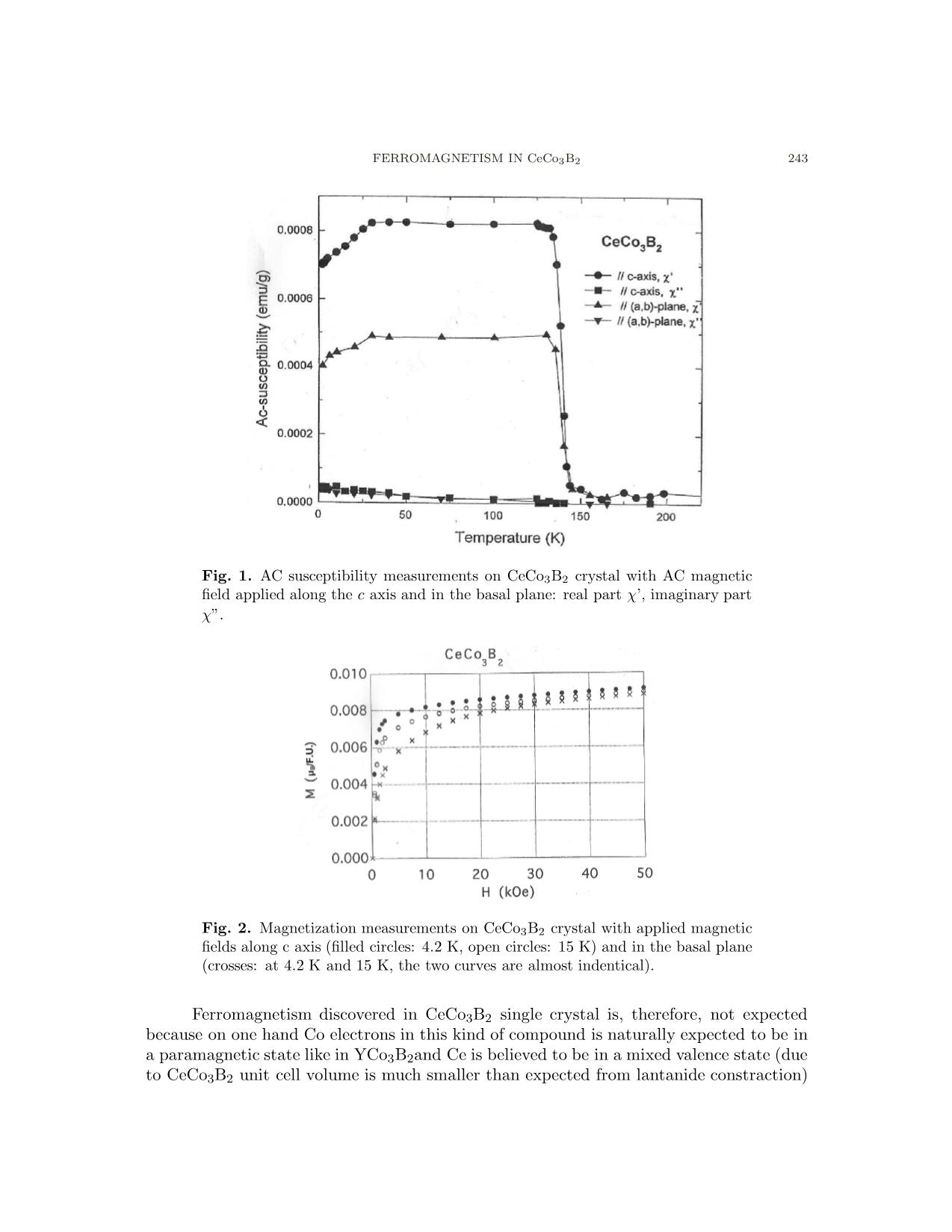
Trang 3
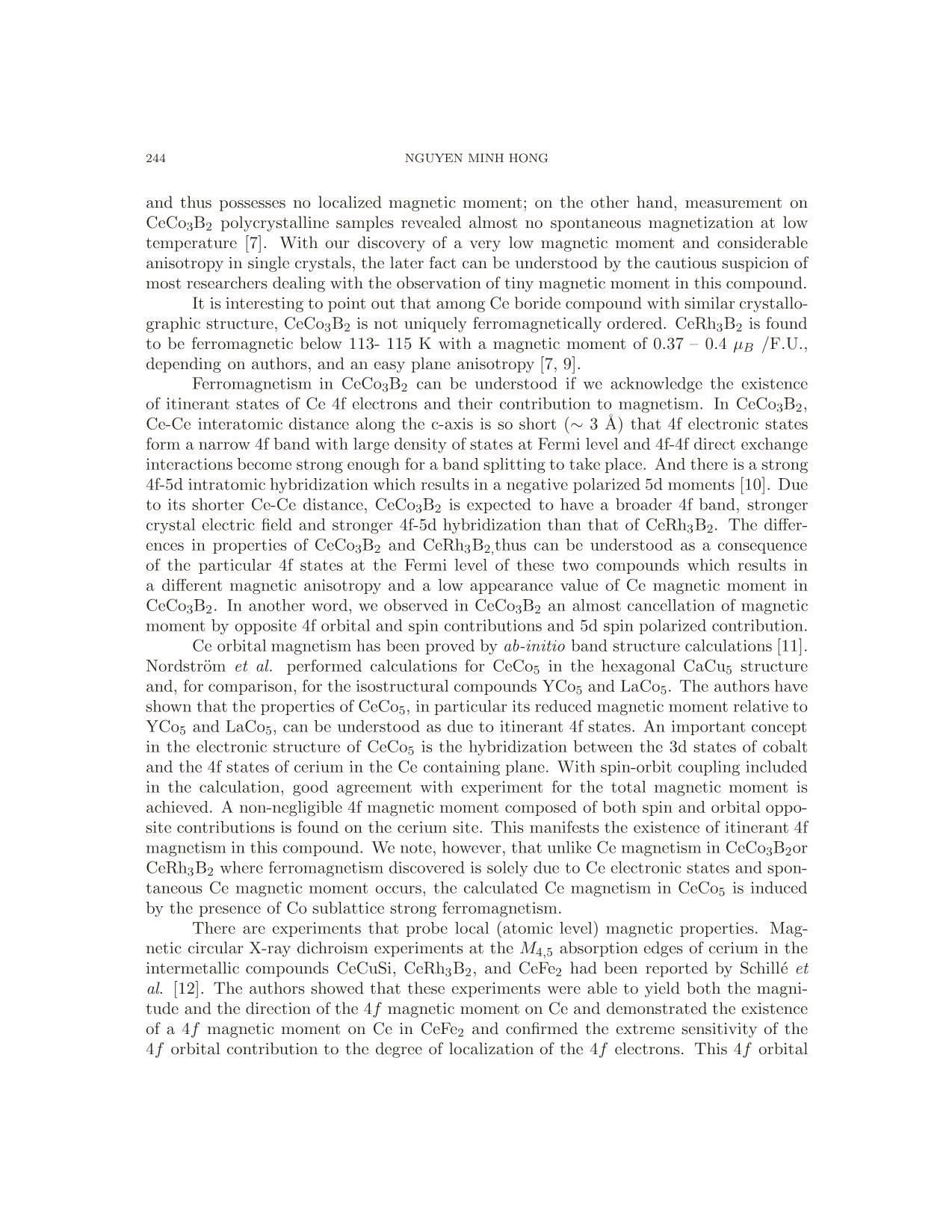
Trang 4
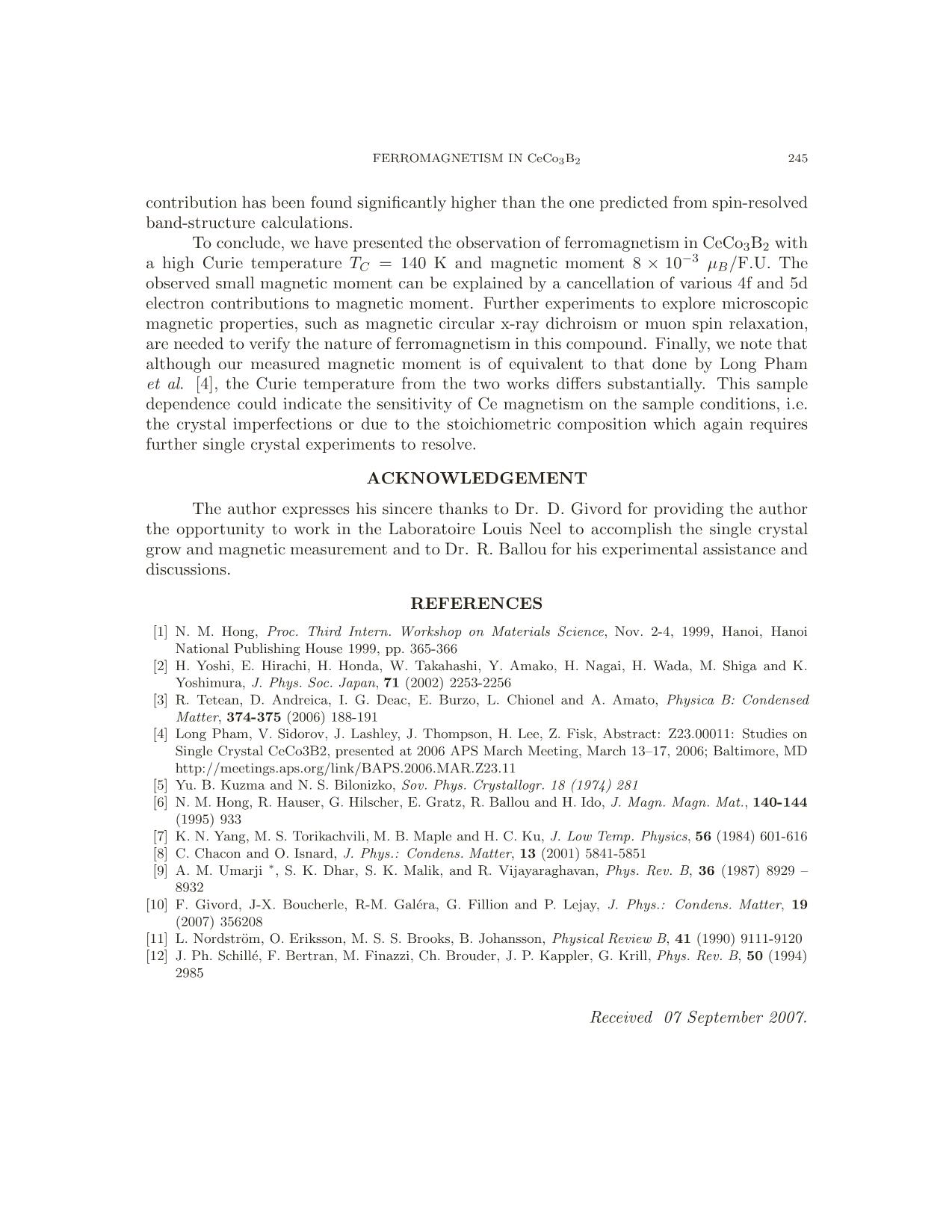
Trang 5

Trang 6
Tóm tắt nội dung tài liệu: Ferromagnetism in CeCo3B2
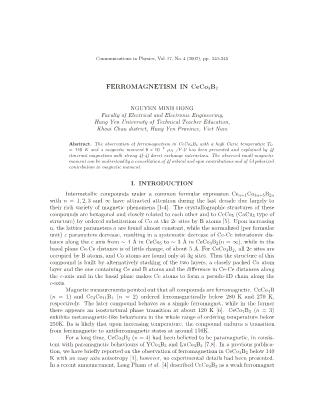
Communications in Physics, Vol. 17, No. 4 (2007), pp. 241-245 FERROMAGNETISM IN CeCo3B2 NGUYEN MINH HONG Faculty of Electrical and Electronic Engineering, Hung Yen University of Technical Teacher Education, Khoai Chau district, Hung Yen Province, Viet Nam Abstract. The observation of ferromagnetism in CeCo3B2 with a high Curie temperature TC = 140 K and a magnetic moment 8 × 10−3 µB /F.U has been presented and explained by 4f itinerant magnetism with strong 4f-4f direct exchange interaction. The observed small magnetic moment can be understood by a cancellation of 4f orbital and spin contributions and of 5d polarized contribution to magnetic moment. I. INTRODUCTION Intermetallic compounds under a common formular expression Cen+1Co3n+5B2n with n = 1, 2, 3 and ∞ have attracted attention during the last decade due largely to their rich variety of magnetic phenomena [1-4]. The crystallographic structures of these compounds are hexagonal and closely related to each other and to CeCo5 (CaCu5 type of structure) by ordered substitution of Co at the 2c sites by B atoms [5]. Upon increasing n, the lattice parameters a are found almost constant, while the normalized (per formular unit) c parameters decrease, resulting in a systematic decrease of Ce-Ce interatomic dis- tance along the c axis from ∼ 4 A˚ in CeCo5 to ∼ 3 A˚ in CeCo3B2(n = ∞), while in the basal plane Ce-Ce distance is of little change, of about 5 A˚. For CeCo3B2, all 2c sites are occupied by B atoms, and Co atoms are found only at 3g sites. Thus the structure of this compound is built by alternatively stacking of the two layers, a closely packed Co atom layer and the one containing Ce and B atoms and the difference in Ce-Ce distances along the c-axis and in the basal plane makes Ce atoms to form a pseudo-1D chain along the c-axis. Magnetic measurements pointed out that all compounds are ferromagnetic. CeCo4B (n = 1) and Ce3Co11B4 (n = 2) ordered ferromagnetically below 280 K and 270 K, respectively. The later compound behaves as a simple ferromagnet, while in the former there appears an isostructural phase transition at about 120 K [6]. CeCo7B3 (n = 3) exhibits metamagnetic-like behaviours in the whole range of ordering temperature below 250K. Its is likely that upon increasing temperature, the compound endures a transition from ferrimagnetic to antiferromagnetic states at around 150K. For a long time, CeCo3B2 (n = 4) had been believed to be paramagnetic, in consis- tent with paramagnetic behaviours of YCo3B2 and LuCo3B2 [7,8]. In a previous publica- tion, we have briefly reported on the observation of ferromagnetism in CeCo3B2 below 140 K with an easy axis anisotropy [1], however, no experimental details had been presented. In a recent announcement, Long Pham et al. [4] described CeCo3B2 as a weak ferromagnet 242 NGUYEN MINH HONG below 210 K with a magnetic moment of 0.01 µB at low temperature. However, over a year has past since their announcement, details of their experiments have not been published and available. In this communication, we report on the first magnetic measurements on a CeCo3B2 single crystal and discuss the obtained results in term of Ce 4f delocalized electron contri- butions to magnetism. II. EXPERIMENTAL RESULTS Experiments were carried out on facilities of Laboratoire du Magnetisme Louis Ne´el (CNRS, Grenoble, France). CeCo3B2 single crystal had been grown from ingots with norminal composition Ce1+δCo3B2 by Czochralski method in an induction furnace with cold crucible. An access in Ce, denoted by atomic percent δ, had been appropriately chosen to compensate the Ce lost during the melting and crystal growing process. Tiny good crystals with weights of a few milligrams were obtained and the quality and orientation of crystal were checked by Laue method. Lattice parameters obtained by Debye- Scherrer method at room temperature are a = 5.056 ± 0.003 A˚ and c = 3.038 ± 0.002 A˚, in good agreement with literature [5]. AC susceptibility (in zero DC field) and magnetization measurements (with mag- netic fields up to 50 kOe) along the c-axis and in the basal plane of a crystal of 1 mg in mass have been performed on a Quantum Design Magnetometer. The AC susceptibility results are shown in Fig. 1. A ferromagnetic transition is clear seen at TC = 140±1 K. The measured susceptibility is larger along the c-axis than in the (a,b)-plane indicating an easy axis anisotropy of CeCo3B2, in consistent with the magnetization measurement presented below. We note that below 30 K, there is a pronounced decrease in susceptibility along both two directions. If this is a spin reorientation, a decrease in susceptibility along the c-axis would imply an increase in the susceptibility in the basal plane, which is clearly not the case. It is likely, thus, this is a transition associated not with the magnetic moment orientation, but with its amplitude or with the magnetic hardness of the compound in both directions. Further experiments are needed to clarify the nature of this phenomenon. Magnetization curves at 4.2 K are presented in Fig. 2. The easy direction is indeed along the c-axis from which a magnetic moment of 8 × 10−3 µB/F.U. is deduced. The curve measured in the basal plane does not reach saturation up to 50 kOe, however the anisotropy is relatively low, because of small value of magnetic moment. III. DISCUSSIONS Structural and magnetic property investigations of Yn+1Co3n+5B2n by neutron diffraction had revealed a close relationship between amplitude of Co magnetic moments and the presence of boron in the neighborhood of the cobalt atoms [8]. It is stipulated that the hybridization of the cobalt 3d electronic state with the boron 2p state plays a major role in the determination of the magnitude of Co magnetic moments and this accounts for the paramagnetic state in YCo3B2 where each Co atom is surrounded by up to four B atoms. FERROMAGNETISM IN CeCo3B2 243 Fig. 1. AC susceptibility measurements on CeCo3B2 crystal with AC magnetic field applied along the c axis and in the basal plane: real part χ’, imaginary part χ”. Fig. 2. Magnetization measurements on CeCo3B2 crystal with applied magnetic fields along c axis (filled circles: 4.2 K, open circles: 15 K) and in the basal plane (crosses: at 4.2 K and 15 K, the two curves are almost indentical). Ferromagnetism discovered in CeCo3B2 single crystal is, therefore, not expected because on one hand Co electrons in this kind of compound is naturally expected to be in a paramagnetic state like in YCo3B2and Ce is believed to be in a mixed valence state (due to CeCo3B2 unit cell volume is much smaller than expected from lantanide constraction) 244 NGUYEN MINH HONG and thus possesses no localized magnetic moment; on the other hand, measurement on CeCo3B2 polycrystalline samples revealed almost no spontaneous magnetization at low temperature [7]. With our discovery of a very low magnetic moment and considerable anisotropy in single crystals, the later fact can be understood by the cautious suspicion of most researchers dealing with the observation of tiny magnetic moment in this compound. It is interesting to point out that among Ce boride compound with similar crystallo- graphic structure, CeCo3B2 is not uniquely ferromagnetically ordered. CeRh3B2 is found to be ferromagnetic below 113- 115 K with a magnetic moment of 0.37 – 0.4 µB /F.U., depending on authors, and an easy plane anisotropy [7, 9]. Ferromagnetism in CeCo3B2 can be understood if we acknowledge the existence of itinerant states of Ce 4f electrons and their contribution to magnetism. In CeCo3B2, Ce-Ce interatomic distance along the c-axis is so short (∼ 3 A˚) that 4f electronic states form a narrow 4f band with large density of states at Fermi level and 4f-4f direct exchange interactions become strong enough for a band splitting to take place. And there is a strong 4f-5d intratomic hybridization which results in a negative polarized 5d moments [10]. Due to its shorter Ce-Ce distance, CeCo3B2 is expected to have a broader 4f band, stronger crystal electric field and stronger 4f-5d hybridization than that of CeRh3B2. The differ- ences in properties of CeCo3B2 and CeRh3B2,thus can be understood as a consequence of the particular 4f states at the Fermi level of these two compounds which results in a different magnetic anisotropy and a low appearance value of Ce magnetic moment in CeCo3B2. In another word, we observed in CeCo3B2 an almost cancellation of magnetic moment by opposite 4f orbital and spin contributions and 5d spin polarized contribution. Ce orbital magnetism has been proved by ab-initio band structure calculations [11]. Nordstro¨m et al. performed calculations for CeCo5 in the hexagonal CaCu5 structure and, for comparison, for the isostructural compounds YCo5 and LaCo5. The authors have shown that the properties of CeCo5, in particular its reduced magnetic moment relative to YCo5 and LaCo5, can be understood as due to itinerant 4f states. An important concept in the electronic structure of CeCo5 is the hybridization between the 3d states of cobalt and the 4f states of cerium in the Ce containing plane. With spin-orbit coupling included in the calculation, good agreement with experiment for the total magnetic moment is achieved. A non-negligible 4f magnetic moment composed of both spin and orbital oppo- site contributions is found on the cerium site. This manifests the existence of itinerant 4f magnetism in this compound. We note, however, that unlike Ce magnetism in CeCo3B2or CeRh3B2 where ferromagnetism discovered is solely due to Ce electronic states and spon- taneous Ce magnetic moment occurs, the calculated Ce magnetism in CeCo5 is induced by the presence of Co sublattice strong ferromagnetism. There are experiments that probe local (atomic level) magnetic properties. Mag- netic circular X-ray dichroism experiments at the M4,5 absorption edges of cerium in the intermetallic compounds CeCuSi, CeRh3B2, and CeFe2 had been reported by Schille´ et al. [12]. The authors showed that these experiments were able to yield both the magni- tude and the direction of the 4f magnetic moment on Ce and demonstrated the existence of a 4f magnetic moment on Ce in CeFe2 and confirmed the extreme sensitivity of the 4f orbital contribution to the degree of localization of the 4f electrons. This 4f orbital FERROMAGNETISM IN CeCo3B2 245 contribution has been found significantly higher than the one predicted from spin-resolved band-structure calculations. To conclude, we have presented the observation of ferromagnetism in CeCo3B2 with a high Curie temperature TC = 140 K and magnetic moment 8 × 10−3 µB/F.U. The observed small magnetic moment can be explained by a cancellation of various 4f and 5d electron contributions to magnetic moment. Further experiments to explore microscopic magnetic properties, such as magnetic circular x-ray dichroism or muon spin relaxation, are needed to verify the nature of ferromagnetism in this compound. Finally, we note that although our measured magnetic moment is of equivalent to that done by Long Pham et al. [4], the Curie temperature from the two works differs substantially. This sample dependence could indicate the sensitivity of Ce magnetism on the sample conditions, i.e. the crystal imperfections or due to the stoichiometric composition which again requires further single crystal experiments to resolve. ACKNOWLEDGEMENT The author expresses his sincere thanks to Dr. D. Givord for providing the author the opportunity to work in the Laboratoire Louis Neel to accomplish the single crystal grow and magnetic measurement and to Dr. R. Ballou for his experimental assistance and discussions. REFERENCES [1] N. M. Hong, Proc. Third Intern. Workshop on Materials Science, Nov. 2-4, 1999, Hanoi, Hanoi National Publishing House 1999, pp. 365-366 [2] H. Yoshi, E. Hirachi, H. Honda, W. Takahashi, Y. Amako, H. Nagai, H. Wada, M. Shiga and K. Yoshimura, J. Phys. Soc. Japan, 71 (2002) 2253-2256 [3] R. Tetean, D. Andreica, I. G. Deac, E. Burzo, L. Chionel and A. Amato, Physica B: Condensed Matter, 374-375 (2006) 188-191 [4] Long Pham, V. Sidorov, J. Lashley, J. Thompson, H. Lee, Z. Fisk, Abstract: Z23.00011: Studies on Single Crystal CeCo3B2, presented at 2006 APS March Meeting, March 13–17, 2006; Baltimore, MD [5] Yu. B. Kuzma and N. S. Bilonizko, Sov. Phys. Crystallogr. 18 (1974) 281 [6] N. M. Hong, R. Hauser, G. Hilscher, E. Gratz, R. Ballou and H. Ido, J. Magn. Magn. Mat., 140-144 (1995) 933 [7] K. N. Yang, M. S. Torikachvili, M. B. Maple and H. C. Ku, J. Low Temp. Physics, 56 (1984) 601-616 [8] C. Chacon and O. Isnard, J. Phys.: Condens. Matter, 13 (2001) 5841-5851 [9] A. M. Umarji ∗, S. K. Dhar, S. K. Malik, and R. Vijayaraghavan, Phys. Rev. B, 36 (1987) 8929 – 8932 [10] F. Givord, J-X. Boucherle, R-M. Gale´ra, G. Fillion and P. Lejay, J. Phys.: Condens. Matter, 19 (2007) 356208 [11] L. Nordstro¨m, O. Eriksson, M. S. S. Brooks, B. Johansson, Physical Review B, 41 (1990) 9111-9120 [12] J. Ph. Schille´, F. Bertran, M. Finazzi, Ch. Brouder, J. P. Kappler, G. Krill, Phys. Rev. B, 50 (1994) 2985 Received 07 September 2007.
File đính kèm:
 ferromagnetism_in_ceco3b2.pdf
ferromagnetism_in_ceco3b2.pdf

